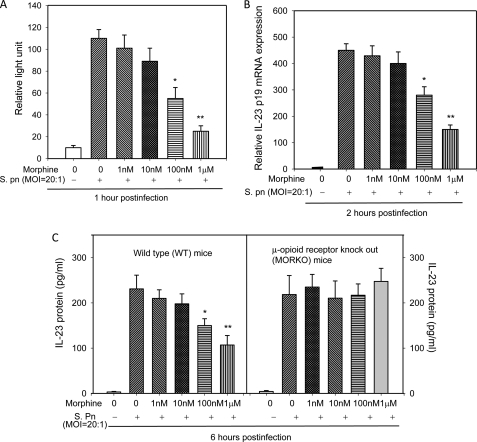FIGURE 2.
Effect of morphine treatment on IL-23 promoter activity, mRNA expression, and protein synthesis in BMDCs infected with S. pneumoniae. A, BMDCs were transfected with 5 μg of the pGL3B-IL-23p19 firefly luciferase reporter plasmid and co-transfected with 0.5 μg of pRL-TK plasmid-driving Renilla luciferase. After 2 h of transfection, cells were treated with vehicle or morphine (1 nm–1 μm) for 24 h prior to infection with S. pneumonia (S. pn). Lysates were harvested after 1 h and assayed for firefly and Renilla luciferase activity using a Dual-Luciferase reporter kit. Data are presented as relative light units after correction for transfection efficiency by normalization with pRL-TK driving Renilla luciferase. B, BMDCs were treated with low and high dose morphine for 24 h and then infected with S. pneumoniae (m.o.i., 20:1) for 2 h. mRNA expression of IL-23 was determined by real-time PCR. C, BMDCs from WT and μ-opioid receptor knock-out (MORKO) mice were treated with low and high dose morphine for 24 h and then infected with S. pneumoniae (m.o.i., 20:1) for 6 h. The protein expression of IL-23 in culture supernatant was measured by enzyme-linked immunosorbent assay. Data shown are the mean ± S.E. of three separate experiments. Statistical differences were determined by a factorial analysis of variance followed by an unpaired t test. *, significance at level p < 0.05; **, significance at level p < 0.01 compared with the control group.

